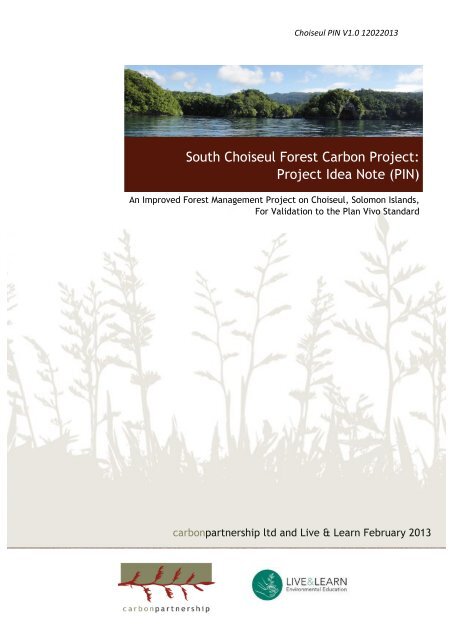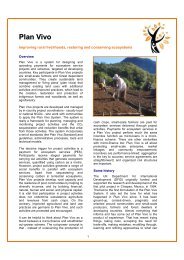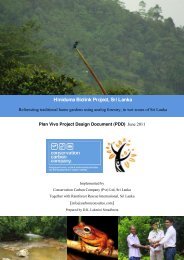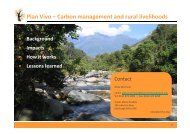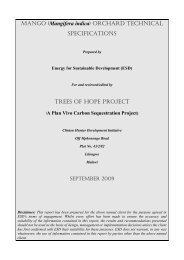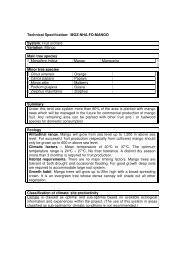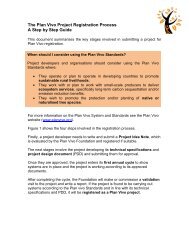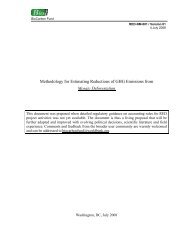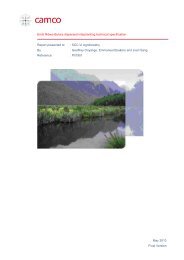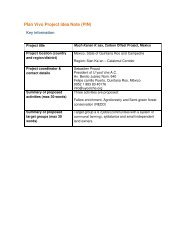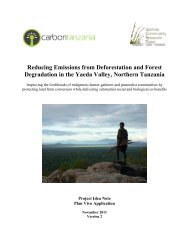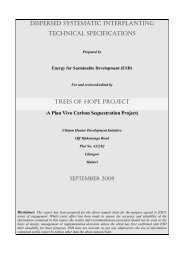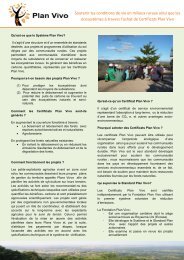Download PIN - Plan Vivo
Download PIN - Plan Vivo
Download PIN - Plan Vivo
- No tags were found...
You also want an ePaper? Increase the reach of your titles
YUMPU automatically turns print PDFs into web optimized ePapers that Google loves.
Choiseul <strong>PIN</strong> V1.0 12022013 South Choiseul Forest Carbon Project:Project Idea Note (<strong>PIN</strong>)An Improved Forest Management Project on Choiseul, Solomon Islands,For Validation to the <strong>Plan</strong> <strong>Vivo</strong> Standardcarbonpartnership ltd and Live & Learn February 2013
Choiseul <strong>PIN</strong> V1.0 12022013 A project of Live & Learn Environmental Education in collaboration with Carbon Partnership Ltd. Report prepared for the <strong>Plan</strong> <strong>Vivo</strong> Foundation by Sean Weaver of Carbon Partnership Ltd. Sean Weaver, Principal, Carbon Partnership Ltd. PO Box 215, Takana 7142, Tasman, New Zealand. Ph: +64 3 525 6073 email: sean.weaver@carbon-‐partnership.com Web: www.carbon-‐partnership.com ___________________________ With contributions from: Anjali Nelson, Live & Learn Environmental Education Email: anjali.nelson@livelearn.org Bill Apusae, Live & Learn Environmental Education Email: bill.apusae@livelearn.org Cover Photo: Choiseul Coastal Forest (Weaver) Suggested citation for this report: Weaver, S.A. Nelson, A. and Apusae, B. 2013. South Choiseul Forest Carbon Project: Project Idea Note. An Improved Forest Mangement Project on Choiseul Island, Solomon Islands. Live & Learn Environmental Education, Honiara, Solomon Islands and Carbon Partnership Ltd. Takaka, New Zealand. 2
Choiseul <strong>PIN</strong> V1.0 12022013 Table of Contents DOCUMENT FORMAT...................................................................................................5 1. ELIGIBILITY ...............................................................................................................6 1.1 Producers................................................................................................................... 6 1.1.1 Small Scale Farmers ............................................................................................. 6 1.1.2 Community Organisation ..................................................................................... 7 1.1.3 Livelihood Needs.................................................................................................. 8 1.1.4 Community-‐Owned Land ..................................................................................... 8 1.2. Project Coordinators ................................................................................................ 9 1.2.1 In-‐Country Presence............................................................................................. 9 1.2.2 Capability ........................................................................................................... 10 1.2.3 Government Relations ....................................................................................... 11 1.2.4 Training .............................................................................................................. 12 1.2.5 Voluntary Participation ...................................................................................... 12 1.2.6 Producers Own Carbon ...................................................................................... 13 1.2.7 Equitable & Transparent Payments ................................................................... 13 1.3. Land Tenure / Use Rights........................................................................................ 13 1.3.1 Secure Tenure .................................................................................................... 13 1.4. Project Activities..................................................................................................... 15 1.4.1 Community Control............................................................................................ 15 1.4.2 Eligible Activities ................................................................................................ 15 1.4.3 Additionality, Leakage, Permanence.................................................................. 15 1.4.4 Native Species .................................................................................................... 16 1.4.5 Minimize Dependency ....................................................................................... 17 1.5. Project Landscape................................................................................................... 17 1.5.1 Boundaries ......................................................................................................... 17 1.5.2 Activities............................................................................................................. 17 1.6. Expansion Ambitions .............................................................................................. 18 1.6.1 Learning By Doing .............................................................................................. 18 1.6.2 Practicable.......................................................................................................... 18 2. PLAN VIVO <strong>PIN</strong> TEMPLATE......................................................................................19 2.1. Key Information...................................................................................................... 19 2.2. Project Objectives and Activities ............................................................................ 20 2.2.1 Project Objectives .............................................................................................. 20 2.2.2 Project Activities ................................................................................................ 20 2.2.3 Additional Activities ........................................................................................... 21 2.3 Identify Target Groups/Communities...................................................................... 21 2.4 Description of Proposed Project Area ..................................................................... 22 2.4.1 Sassamungga Territory....................................................................................... 22 2.4.2 Nggoreambarra Territory................................................................................... 22 3
Choiseul <strong>PIN</strong> V1.0 12022013 2.4.3 Description Of Land In Both Areas ..................................................................... 23 2.5 Physical Environment .............................................................................................. 24 2.5.1 Maps .................................................................................................................. 25 2.5.2 Conservation Areas ............................................................................................ 29 2.5.3 Physical Description Of Land And Habitat Types ............................................... 30 2.5.4 Current Land Use ............................................................................................... 31 2.5.5 Land Degradation Processes .............................................................................. 31 2.6 Socio-‐Economic Environment.................................................................................. 31 2.6.1 Description of Local Cultural Groups ................................................................. 32 2.6.2 Average Income And Main Income Sources ...................................................... 32 2.6.3 Local And National Governance Structures ....................................................... 33 2.7 Availability Of Technical Data.................................................................................. 33 2.8 Ownership of carbon rights and land-‐tenure .......................................................... 33 2.8.1 Land Tenure Context.......................................................................................... 34 2.8.2 Carbon Rights..................................................................................................... 35 2.8.3 Typical Size Range Of Land Holdings.................................................................. 35 2.8.4 Conflict Issues .................................................................................................... 36 2.9 Description of applicant organisation ..................................................................... 36 2.9.1 Project Coordinator Description ........................................................................ 38 2.9.2 External Support Services .................................................................................. 38 2.9.3 Applicant Details ................................................................................................ 38 2.10 Community-‐Led Design <strong>Plan</strong> Submitted................................................................ 41 2.10.1 Community-‐Led Design <strong>Plan</strong> ............................................................................ 41 2.10.2 On-‐Going Consultation <strong>Plan</strong>............................................................................. 41 2.11 Additionality Analysis Provided ............................................................................. 43 2.11.1 Regulatory Surplus ........................................................................................... 43 2.11.2 Commercial Viability Without Crediting .......................................................... 43 2.11.3 Project Implementation Barriers...................................................................... 43 2.11.4 Overcoming Implementation Barriers ............................................................. 44 2.12 Compliance With Regulations ............................................................................... 44 2.12.1 Notification Of Relevant National Regulatory Body......................................... 44 2.12.2 Statement Of Compliance Intention ................................................................ 44 2.13 Sources Of Start-‐Up Funding Identified................................................................. 45 4
Choiseul <strong>PIN</strong> V1.0 12022013 Document FormatThis document uses the following convention: Text contained in a yellow box in italics signifies verbatim methodological requirements and/or methodological guidance. Where no italics are used in a yellow box then the methodological guidance has been paraphrased. The specific source of the information is provided for transparency. Black font signifies completed information/data provided by the Live & Learn and Carbon Partnership project development team. Nggoreambarra River, South Choiseul (Weaver). 5
Choiseul <strong>PIN</strong> V1.0 12022013 1. Eligibility The project applies to land over which the target groups have ownership or long-‐term user rights. There are no significant disputes or issues in the proposed project area relating to land-use rights or any issue, which could significantly affect the implementation or long-‐term viability of the project. Source: <strong>Plan</strong> <strong>Vivo</strong> Standards 2008, pg.29. 1.1 PRODUCERS1.1.1 Small Scale FarmersProducers must be small-‐scale farmers, land-‐users or forest dwellers in developing countries with recognised land tenure or user rights PV Eligibility Checklist, p1 Sasamungga Area, Choiseul • Population – approximately 1,000 • Population included in REDD+ project – Approximately 300+ • Religion – Most dominated by United Church • It has primary school grade 1-‐6 and Community high school Form 1-‐5 • It has a hospital run by United Church • The REDD+ project will work on land held under customary ownership by the Sirebe tribe and Vuri tribe. Nggoreambarra Area, Choiseul • Population – approximately 500 • Religion – mostly dominated by Seventh Day Adventist Church • The REDD+ project will work on land held under the customary ownership by the Borovai tribe. The Sirebe and Vuri tribes within the area of Sasamunga and Borovai tribe of Nggoreambara area are located on the southern coastline of the Choiseul Islands in the northern part of the Solomon Islands. Note that Borovai tribal land is known locally as Sambe Land. The Choiseul Island Province is situated at the boarder of PNG and Solomon Islands, neighbouring Bougainville. Southwest Choiseul is composed of lowland rainforests. The inhabitants of Choiseul are mostly of Melanesian descent. The tribes in the Sasamunga and Nggoreambara areas live a mainly subsistence lifestyle living off the land via hunting, fishing and growing root crops and vegetables in small-‐scale 6
Choiseul <strong>PIN</strong> V1.0 12022013 agricultural plots. While income via royalties from timber is common on the island, low levels of income are generated through labour in timber production, cash crops and copra. These activities generate approximately USD70/month to each community. The Producers are heavily reliant on the forest area on their land as it provides them with: • Building Materials • Food source • Income • Medicine • Firewood • Hunting ground • Gardening • Coconut plantation • Timber Sources: Rapid Assessment of Perceptions (RAP) Report, 2011, Live & Learn Environmental Education, Solomon Islands. Choiseul Province Development Profile, UNDP/UNOPS, SIDAPP and Ministry of Provincial Government and Rural Development Report, 2001. 1.1.2 Community OrganisationProducers must be organised into cooperatives, associations, community-‐based organisations or other organisational forms able to contribute to the social and economic development of their members and communities and democratically controlled by the members PV Eligibility Checklist, p1 The three tribes engaged in the project will work through the structure of community-‐based co-‐operatives. The Sirebe tribal group has already established a CBO (Community Based Organization) called ELBAR. This CBO has established a community learning centre, a rest house, two way radio and solar panels/systems and have decided to conserve their forest (tribe agreed to conserve their forest). The Vuri tribal group would like to follow the same path, however, they are yet to form any governance structures for this purpose. Under the REDD+ project, we see these two tribes coming together under ELBAR. The Borovai tribe of Nggoreambara wish to work through the Ngalgro Community Development Organisation as a cooperative under this project. The CBO will work in line with the Cooperative Law of Solomon Islands and take learning from Live & Learn Solomon Islands previous experience with community-‐based cooperatives. 7
Choiseul <strong>PIN</strong> V1.0 12022013 Producers will receive small business training through the innovative model of The Money Story. This model for communicating business within communities that have had little access to modern forms of economics has had great success in Australia and Papua New Guinea. Sources Co-‐operative Societies Act [Cap 164], 1996, Solomon Islands Consolidated Legislation Little Fish, The Money Story, www.littlefish.com.au 1.1.3 Livelihood NeedsProducers must be able to use existing forest/ woodland or other land for project activities without undermining livelihood needs PV Eligibility Checklist, p1 The Choiseul Forest Carbon Project will involve an approach whereby the local community that owns and controls resource management of the Project Area forests are able to continue with several non-‐commercial resource management activities within the Project Area. This will include access, harvesting of non-‐wood forest products, harvesting of non-commercial timber for local housing and cultural purposes (within a de minimus threshold that is consistent with the most recent VCS de minimus rule for the Improved Forest Management – Logged to Protected Forest methodological guidance and/or approved methodologies). 1.1.4 Community-Owned LandMust have a registered <strong>Plan</strong> <strong>Vivo</strong> for their own piece of land or be part of a group with a <strong>Plan</strong> <strong>Vivo</strong> for a piece of community-‐owned or managed land. Producers should not be structurally dependent on permanent hired labour, and should manage their land mainly with their own and their family’s labour force PV Eligibility Checklist, p1 Producers in the Sassamungga and Nggoraembara communities have customary ownership of the land upon which the project will take place. This customary ownership is sanctioned in the Constitution of the Solomon Islands. Live & Learn is currently seeking advice, on behalf of the producers, as to the most effective way to protect their current status as customary landowners further under law. This may be through the Customary Land Records Act, local court ruling (Choiseul Province Ordinance) or through the Protected Areas Act (which has provision for legal recognition of customary land ownership and boundaries). 8
Choiseul <strong>PIN</strong> V1.0 12022013 The three tribes involved in the project have provided statements of their claim to ownership of the land. This claim is uncontested by neighbouring tribes as stated in letters from those tribal leaders. The incomes of the Producers are too low to rely on hired labour. The Producers are responsible for managing their customary land area. Sources The Constitution of Solomon Islands [no.783], 1978. Customary Land Records Act [Cap 132] Protected Areas Act, 2010 Letters from Vuri and Sirebe Tribal Leaders stating their land ownership. 1.2. PROJECT COORDINATORS1.2.1 In-Country PresenceMust have a strong in-‐country presence and the respect and experience required to work effectively with local communities and partner PV Eligibility Checklist, p1 Live & Learn Environmental Education has run an office in the Solomon Islands for 17 years. In that time they have run 12 projects that focus on 8 thematic areas being: • Water, Sanitation and Hygiene • Sustainable Use of Biodiversity • Environmental Governance • Natural Resource-‐Based Conflict Management and Peace Building • Climate Change • Sustainable Energy Options • Waste Management and Reduction • Disaster Preparedness and Recovery The Live & Learn Solomon Islands Office is committed to operating in the Solomon Islands for the long term. Incorporated under the Solomon Islands Charitable Trust Act as a local NGO on 1 March 1999 the Solomon Islands office currently has over 32 staff under local management located in Honiara. The Solomon Islands office implements projects for EU, AusAID, NZAID, the MacArthur Foundation, ADB and GEF within the areas of sustainable forest management, environmental governance, and biodiversity conservation education. Projects are implemented nationwide, and specifically on Choiseul, Isabel, Makira, Rennell islands and Western Province. 9
Choiseul <strong>PIN</strong> V1.0 12022013 Sources Good Practice Manual, 2010, Live & Learn Environmental Organisation. 1.2.2 CapabilityMust be focused and have the organisational capability and an ability to mobilise the necessary resources to develop the project PV Eligibility Checklist, p1 Live & Learn has been working in the Asia-‐Pacific region since 1995, with the opening of the Solomon Islands office. Live & Learn now has a further seven offices opened in the Asia-‐Pacific region. The Live & Learn REDD+ program currently operates across Fiji, Vanuatu, the Solomon Islands, Papua New Guinea and Australia. This project will have the support of Live & Learn REDD+ staff and our regional partners. Each Live & Learn Office runs as a locally-‐registered NGO but receives organisational development support from the Live & Learn International Office in Australia. Each country office is run by local staff to ensure that projects are innovative, culturally appropriate and relevant. Our aim is to promote the integration of environmental, human, cultural and peace concepts in all education projects and programs. We have worked across formal and informal education with a range of government and non-‐government partners. In 2011 Live & Learn received funding from the Asian Development Bank to “design effective models for governance and implementation of REDD+ in the Solomon Islands to provide equitable benefits for forest-‐dependent indigenous people.” So far Live & Learn has: • produced a facilitator’s guide for educating communities on Climate Change, REDD+ and the value of Forests (now being tested regionally), • produced detailed reports on land tenure and carbon property rightsand implications for community REDD+ in the Solomon Islands, • produced a detailed report on REDD+ Readiness in the Solomon Islands and current governance arrangements in the country, • developed an MOU with Natural Resources Development Foundation (NRDF), • engaged two communities in a Rapid Assessment of Perceptions and subsequent education in climate change and REDD+. • Enhanced the capacity of local staff to work in REDD+ including attendance at international training and conferences The work of our Solomon Islands and Regional REDD+ team has attracted the interest of international donors who are keen to provide financial and technical support to develop the project into a full implementation phase. 10
Choiseul <strong>PIN</strong> V1.0 12022013 As one of the key NGOs engaged in REDD+ in the Pacific, Live & Learn’s strong relationship with key players and ability to enhance local capacity to work in REDD+ is mirrored in other project sites in Vanuatu and Fiji. With support across the region and from key technical specialists, Live & Learn is mobilised and ready to further its work in the Solomon Islands. 1.2.3 Government RelationsMust have the capability to negotiate and deal with government, local organisations & institutions, and buyers of ecosystem services PV Eligibility Checklist, p1 Live & Learn has long lasting and trusted connections with a range of stakeholders in the Solomon Islands. Of particular importance to the REDD+ project is the MOU with NRDF (a project partner), our relationship with the Department of Forestry and Research and our partnership with the European Union. Some of Live & Learn Solomon Islands’ relations with government and non-‐government entities are outlined briefly below. Live & Learn Solomon Islands Office have signed MOUs with the following partners: • MOU – NRDF (Natural Resource Development Foundation) and Live & Learn Environmental Education Solomon Islands (ADB REDD+ Project) • MOU – CDC (Curriculum Development Centre) Ministry of Education and Human Resources and Live & Learn Environmental Education Solomon Islands • MOU – TDA (Tetepare Descendent Association) and Live & Learn Environmental Education Solomon Islands Live & Learn Solomon Islands Office work actively with the following development partners: • UNREDD Program (Live & Learn are members of the Solomon Islands REDD+ Taskforce established through UNREDD) • Asian Development Bank (ADB) • Australia Agency for International Development (AusAid) • European Union (EU) • Save the Children • United Nation Development Program (UNDP) • United Nation Children’s Fund (UNICEF) • World Wide Fund for Nature (WWF) • United Nations Human Settlements Program (UN-‐HABITAT) Live & Learn Solomon Islands Office work actively with the following Government Partners: • Ministry of Environment, Conservation, Disaster Management and Meteorology • Ministry of Forestry and Research • Ministry of Women, Youth and Children Affairs 11
Choiseul <strong>PIN</strong> V1.0 12022013 • Ministry of Education and Human Resource Management • Ministry of Health and Medical Services 1.2.4 TrainingMust have the ability to mobilise and train participants, implement and monitor project activities, carry out technical functions PV Eligibility Checklist, p1 Live & Learn is first and foremost a community development organisation, with strong capacity in education and participatory processes. The organisation has developed a Climate Change and REDD Facilitators Guide that seeks to support the achievement of Free, Prior and Informed Consent of indigenous forest dependent peoples in the Pacific for REDD activities. The Live & Learn Solomon Island’s Office is run and managed by ethnic Solomon Islanders with a breadth of experience in undertaking community-‐based environmental projects requiring community education, data collection and analysis and project monitoring and evaluation. The Solomon Island REDD+ Project Coordinator receives technical support from Live & Learn’s Regional REDD+ Technical Advisor. In addition to this Live & Learn works in partnership with Dr. Sean Weaver of Carbon Partnership Ltd who provides the specialist technical training expertise for the project. 1.2.5 Voluntary ParticipationMust recognise that the decision of producers to participate in project activities is entirely voluntary PV Eligibility Checklist, p1 Live & Learn have understood from the beginning of this project that the participation of producers in this project is entirely voluntary. Our discussions with producers in early stages of community consultation activities have made this clear to them. Live & Learn is committed to working at the pace of the community and ensuring their free, prior and informed consent. This process began with a Rapid Assessment of Perceptions in 2011 to identify key attributes of the community and their initial desires for development of their forest resources. Live & Learn will undertake further education through workshops and videos to provide awareness of climate change, REDD+ and the importance of decisions around resource use. Only after this and a full plan is developed for the project are the communities asked to commit to the project. Live and Learn will not place the communities in a position where they have no option but to undertake the project. 12
Choiseul <strong>PIN</strong> V1.0 12022013 1.2.6 Producers Own CarbonMust recognise that producers own the carbon benefits of the project activities they choose to undertake PV Eligibility Checklist, p1 Live & Learn understand that the owners of the carbon rights and the carbon benefits in this project are the producers themselves. We see our role as a facilitator of their community development through the implementation of this project. We are strongly committed to assist these communities to maximize their benefits from this project because our goal is to save rainforests and we know that doing so is dependent upon the delivery of enduring community economic development. 1.2.7 Equitable & Transparent PaymentsMust ensure that the PES producers receive are fair and equitable and that payments are made in a transparent and traceable manner PV Eligibility Checklist, p1 To deliver on our own goals of maximizing rainforest protection we have a strong commitment to ensuring that the payments for ecosystem services to producers are as high as possible and where they fully understand their rights and responsibilities. Part of our capability (through a technical partner called Little Fish) includes transparent community financial management using a community financial management instrument called “the Money Story”. Live & Learn as a project coordination organization will not seek ongoing income from PES activities undertaken by producers, but look to ensure that PES is used for ongoing monitoring costs and dispensed to producers via a community cooperative under good governance systems. 1.3. LAND TENURE / USE RIGHTS1.3.1 Secure TenureLand tenure and use rights must be secure (land tenure or use rights) so that there can be clear ownership, traceability and accountability for carbon reduction or sequestration benefits PV Eligibility Checklist, p1 The Constitution of the Solomon Islands outlines the ownership of land and rights to natural resources of the people of Solomon Islands. The vast majority of land (86%) is held under legally recognised customary tenure. Customary tenure is governed by customary laws, which differ from place to place and are generally not written down. However custom law is 13
Choiseul <strong>PIN</strong> V1.0 12022013 used to determine group membership and tribal land boundaries. This situation applies to the producer communities in this project. Land in Sasamungga is owned by two separate tribal groups. The two tribes were Sirebe tribe and Vuri tribe. The two tribes claim to be the rightful owners of the land and they have customary land use rights over the land. Sirebe tribal land in Sasamungga is owned by the Sirebe tribe, who have written documents to show and prove that they are the rightful owners of the land. The Vuri sub-‐tribal land is part of the main Sikipozo tribal land in Sasamungga. It is land allocated to the Vuri sub-‐tribe by the Sikipozo tribe. The Vuri land and project site belongs to Myknee Sirikolo’s Father (1 st born son) and his two younger brothers; it is one of the three sub divisions of land allocated from main Sikipozo tribal land. There are written records of the land ownership rights demonstrating that the land is owned by Vuri tribe. Sambe land is owned by a particular tribe called Borovai. The majority of the Borovai tribal group live in the village called Ngorreambarra and few people currently reside upon or use the Sambe land where the project is proposed. The land area involved in this REDD+ project is considered land held under customary tenure. While this is legally recognised, further legal recognition of actual land boundaries is required. Live & Learn as project coordinator will work with the customary landowners to determine the most efficient and effective avenue for recognized tenure through the Customary Land Recording Act [Cap 132], local court ruling (Choiseul Provincial Ordinance) or through the Protected Areas Act (which has provision for legal recognition of customary land ownership and boundaries). A preliminary anthropological assessment commissioned by Live & Learn suggests that there is a clear pathway for determining legal land tenure and use rights for the participating groups, this conclusion was largely based upon the level of informal agreements between the neighbouring tribes. Legal determination of land boundaries and associated mapping would be a significant focus of project development going forward. Sources: The Constitution of Solomon Islands [no.783], 1978. Customary Land Recording Act [Cap 132]. Protected Areas Act, 2010 Rapid Assessment of Perceptions (RAP) Report, 2011, Live & Learn Environmental Education, Solomon Islands. Official letters from landowners of Vuri and Sirebe Tribal Groups (Live & Learn are still waiting on a letter from the Borovae tribal group). 14
Choiseul <strong>PIN</strong> V1.0 12022013 McDonnell, S, Foukouna, J., 2012, Land Law and REDD+ implication in the Solomon Islands: A briefing paper for Live & Learn Environmental Education. Jagger, D. (2012) A report to Live & Learn after consultations with tribal members in Nggoreambarra and Sasamungga, 12 – 16 Nov 2012 1.4. PROJECT ACTIVITIES1.4.1 Community ControlMust enable communities to plan and take control of their resources in a sustainable way that promotes rural livelihoods and other environmental and social co-‐benefits PV Eligibility Checklist, p2 Live & Learn has a strong commitment to community-‐led project design, planning, implementation, monitoring and management. This commitment also applies to the way we are approaching this project, which aims to assist the producer communities to achieve enduring social and economic development benefits derived from a forest conservation initiative financed through a) grants for project development and b) payments for ecosystem services for implementation and on-‐going management. 1.4.2 Eligible ActivitiesMust be eligible to receive payments for ecosystem services (PES) under the <strong>Plan</strong> <strong>Vivo</strong> System, i.e. Afforestation / reforestation, Agroforestry, Forest restoration, Avoided deforestation PV Eligibility Checklist, p2 The project activity is Improved Forest Management – Logged to Protected Forest, which is an activity that falls under the <strong>Plan</strong> <strong>Vivo</strong> project activity category of ‘Avoided Deforestation’. 1.4.3 Additionality, Leakage, PermanenceMust be additional, not liable to cause leakage, and provide foundations for permanence, as described in the <strong>Plan</strong> <strong>Vivo</strong> Standards PV Eligibility Checklist, p2 1.4.3.1 AdditionalityThe project activity in this project comprises long-‐term voluntary protection of lowland rainforests owned by communities seeking economic development from their own natural resources. The principle natural resource owned by the producer communities is rainforest, and the principle means of generating an income capable of financing community economic development is logging. Logging is a common practice in the Solomon Islands and is moving quickly on the island of Choiseul through the rapid uptake of logging licenses by community 15
Choiseul <strong>PIN</strong> V1.0 12022013 landowners. The producers in this project are resisting the logging option because they value forest protection and the ecosystem services it provides, but they cannot sustain this resistance to logging without realizing their economic development aspirations that could otherwise be financed through logging. The forests owned by these communities are not legally protected and there are no plans by the government to finance forest protection in these communities. 1.4.3.2 LeakageThe project activity of forest protection will apply to the vast majority of the rainforest land owned by the producer communities. There is no realistic opportunity for these producers to undertake activity shifting of baseline activities causing the displacement of emissions. The unavailability of commercial timber resources from the lands owned by the Sassamungga and Nggoraembara communities is very unlikely to cause an increase in timber prices because of scarcity, and thereby is very unlikely to cause market leakage. The implementation of this project is designed to include assistance to the producer communities in generating enduring economic development outcomes financed through payments for ecosystem services. This will likely include non-‐commercial harvesting of timber for local housing and cultural activities. These local community development activities including the provision of timber for local non-‐commercial uses is designed to function as a leakage avoidance activity. 1.4.3.3 PermanenceThe foundation for permanence in the project activity is based on building a strong commitment to forest protection among the local population of producers. This strong local commitment to forest protection will depend on the long-‐term flows of financial benefits from payments for ecosystem services, together with effective management of these finances to generate enduring community economic development outcomes. The forests will be legally protected for the project period by means of an instrument designed to bind the producers to project activities for the duration of the project. The project period is provisionally set at 50-‐year periods with perpetual right of renewal. 1.4.4 Native SpeciesMust involve the planting and/or promote the restoration or protection of native or naturalised tree species. PV Eligibility Checklist, p1 The project activity of avoided deforestation / improved forest management does not involve the planting of trees or the establishment of new forests in the project area. The project activity promotes and supports the protection of native forest vegetation communities. 16
Choiseul <strong>PIN</strong> V1.0 12022013 1.4.5 Minimize DependencyMust encourage the development of local capacity and minimise dependency on external support PV Eligibility Checklist, p2 The project is being designed to maximize producer involvement in project management, governance, financing, monitoring, and economic development activity. Live & Learn’s REDD+ work within the South Pacific is piloting effective models for governance and implementation of REDD+ in Small Island Developing States to provide equitable benefits for forest-‐dependent local and indigenous people. The community-‐based approach involves the following elements: • Development of projects on customary land that are cooperatively owned by an indigenous community organisation (e.g. Charitable Trust or Cooperative Society) • Ensuring that indigenous communities’ land and resource ownership rights are protected • Embedding REDD+ activities within a holistic process of community development; fostering links between REDD+ and achievement of other community needs, aspirations and non-‐carbon co-‐benefits • Ensuring that an equitable share of financial benefits from REDD+ are delivered to the indigenous community project owners • Supporting communities in management of REDD+ income (business activities), so that genuine benefits may result and be sustained, which is critical for maintaining incentives for REDD+ permanence. 1.5. PROJECT LANDSCAPE1.5.1 BoundariesMust have clear boundaries that can be mapped PV Eligibility Checklist, p2 Please see maps in section 2.5.1 of this <strong>PIN</strong> below. 1.5.2 ActivitiesMust be suited to the replication and expansion of project activities into new areas PV Eligibility Checklist, p2 The project is being developed as a ‘programme of activities’ or ‘grouped project’. The replication of the project to other areas will be fostered by the design of a methodology that 17
Choiseul <strong>PIN</strong> V1.0 12022013 can be applied to other areas. This will include an administrative methodology for adding new projects to the grouped project. 1.6. EXPANSION AMBITIONS1.6.1 Learning By DoingMust be based on an commitment to initiating activities on a pilot basis, gaining experience, and identifying improvements (‘learning by doing’) PV Eligibility Checklist, p2 The project is being developed as a ‘programme of activities’ or ‘grouped project’. The intention is to develop the Sassamungga and Nggoraembara protected areas as an ‘Inception Project’ to prove the concept and then expand the geographical scope of the project to cover any community on Choiseul or the Solomon Islands who seeks to protect their forests in exchange for the receipt of payments for ecosystem services. This project is also part of a wider Pacific REDD programme by Live & Learn to replicate/duplicate/improve upon the same activities in other parts of the Solomon Islands, Vanuatu and Fiji. The programme of activities / grouped project therefore, is intended to expand across national boundaries to include a Pacific regional programme facilitated by Live & Learn in the region. 1.6.2 PracticableMust be based on practical capabilities ‘on the ground’, not on high level targets imposed from above (‘plant x no. of trees in y years’) PV Eligibility Checklist, p2 The approach to the design, development and implementation of this project is to involve the producer communities as much as possible in order to match project goals and outcomes with local capabilities to deliver on these outcomes. Furthermore, the approach to the project is to offer an opportunity for producers to voluntarily make a commitment to undertaking a project through local recognition of the value of forest protection. Live & Learn takes a ‘bottom up’ approach to scaling REDD+ in the Solomon Islands. This approach enables programme governance, and operational management to remain free from jurisdictional politics and capacity constraints. It is likely to be an effective strategy in the countries where government capacity is low, governance is highly decentralised and where the majority of land is held under customary title. 18
Choiseul <strong>PIN</strong> V1.0 12022013 2. <strong>Plan</strong> <strong>Vivo</strong> <strong>PIN</strong> Template2.1. KEY INFORMATIONKey Information Project title Project location (country and region/district) Project coordinator & contact details Summary of proposed activities (max 30 words) Summary of proposed target groups (max 30 words) South Choiseul Forest Carbon Project Sassamumgga and Nggoraembara, Choiseul Island, Choiseul Province, Solomon Islands. Bill Apusae Live & Learn Environmental Education Lombi Crescent Street, New China Town PO Box 1454, Honiara Solomon Islands P: (+677) 23697 F: (+677)24454 E: solomons@livelearn.org W: www.livelearn.org Activity Type: Improved Forest Management – Conversion of Logged to Protected Forest (IFM-‐LtPF). Baseline Activity: High intensity selective logging. Project Activity: Forest protection. Scope: Inception Project for programme of activities. The Sirebe and Vuri tribes’ of Sasamunga and the Borovai tribe of Nggoreambara live along the southern coastline of Choiseul, Solomon Islands. As subsistence farmers, communities rely heavily on forest resources for food, medicine, timber and kastom practices. South Choiseul Coastline near Nggoreambarra (Weaver). 19
Choiseul <strong>PIN</strong> V1.0 12022013 2.2. PROJECT OBJECTIVES AND ACTIVITIESMax 500 words. • Describe the objectives of the project. • Describe all proposed project activities that will generate <strong>Plan</strong> <strong>Vivo</strong> Certificates (e.g. reforestation, agro forestry, forest conservation) and how they relate to the project objectives. • Describe any additional activities to be supported or implemented by the project and how they relate to the project objectives. NB/ Applicants must demonstrate a willingness to promote the use of indigenous species and recognise that <strong>Plan</strong> <strong>Vivo</strong> activities (i.e. those generating <strong>Plan</strong> <strong>Vivo</strong> Certificates) must be limited to native and naturalised species. Source: 2010 <strong>Plan</strong> <strong>Vivo</strong> <strong>PIN</strong> Template, p4. 2.2.1 Project Objectives1. Develop a carbon-‐crediting programme based on a single activity type (IFM-‐LtPF) in the target communities. This programme will be developed by means of an Inception Project (pilot) designed as the starting point for a Grouped Project (programme of activities) (Phase 1 Development). The purpose of carbon-‐crediting programmes to generates an income for the target communities to enable them to close Project Area forests to logging for the project period. 2. Project Area forests to be legally protected by means of a legal instrument that binds landowners to maintain project activity carbon stocks and make good any reversals. 3. Prove the concept with first transaction from the Inception Project (Phase 1 Implementation). 4. Co-‐develop an economic development plan with the target communities to help deliver core development aspirations. 5. Roll out the Grouped Project provincially or nationally (Phase 2 Implementation). During this phase the Grouped Project will be expanded in scope to include multiple activity types where appropriate. 6. Pilot the opportunity for carbon-‐financing to assist in community development and communicate this learning throughout the Pacific. 7. Provide data to policy makers on the potential for nationally-‐based REDD+ policies to effectively engage custom land owners in the Solomon Islands. 2.2.2 Project Activities1. Legally protect forests inside Project Area boundaries. 2. Allow de minimus non-‐commercial timber harvests for local housing, canoe and cultural needs. 3. Undertake conservation management of protected forests. 20
Choiseul <strong>PIN</strong> V1.0 12022013 4. Undertake community-‐based monitoring of carbon stocks and carbon stock change inside Project Area. 5. Govern project implementation. 6. Undertake land-‐use planning with communities to identify locally-‐based drivers of deforestation and reduce their impact. 7. Manage project finances. 8. Manage community development activities financed by carbon revenues. 2.2.3 Additional ActivitiesThis project may include additional community development initiatives using funding leveraged on the carbon project. This may include • Community energy infrastructures such as biogas from black water feed stocks • Community inshore marine conservation, • Community-‐based business development, • Terrestrial biodiversity conservation management and monitoring, • Community climate change adaptation and resilience activities. This project may also include additional forest carbon management activities that extend the scope of the original carbon project. These activities may include: • Afforestation/reforestation for woodlots • Community agroforestry 2.3 IDENTIFY TARGET GROUPS/COMMUNITIESMax 350 words. Identify and describe the target groups and briefly describe local organisational capacity. “Target groups” are those communities, groups and individuals that are expected to benefit from the project (e.g. rural communities living in and around a certain forest area or women agricultural workers in a certain district). Source: 2010 <strong>Plan</strong> <strong>Vivo</strong> <strong>PIN</strong> Template, p4. Within an area of low population density, this project has decided to target specific tribal groups who have demonstrated a desire for assistance with forest conservation. The Sirebe and Vuri tribal groups depend entirely on their land. Their land provides their main source, and sometimes only source of food, income, medicine, building materials, water, and firewood. The Sirebe tribal group have established a community-‐based organization (CBO) called Elbar CBO. This CBO has established a community learning centre and rest house with two-‐way radio and solar panels. The desire to conserve the forest was initiated by the CBO and agreed to by the community. The Vuri tribal group are yet to form any governance 21
Choiseul <strong>PIN</strong> V1.0 12022013 structures for this purpose. Under the REDD+ project, we see these two tribes coming together under Elbar CBO but this decision will rest with the communities themselves. The Nggorreambarra community, consisting of the Borovai tribal group own the proposed REDD+ site called Sambe. While those living within the community rely heavily on their forest resource, many members of this tribal group are engaged in formal employment and live in urban centres. The Borovai tribal group have formed the Ngalgro Community Development Organisation through which they seek to manage their land and resources. All three tribal groups are governed by Kastom practices that retain a central role in community life. Each tribal group has a chief and community leaders who make decisions for the community regarding customary land issues, conflict resolution and kastom practises. Live & Learn looks to work within existing the governance structures of community-‐organisations and kastom where these structures have the full support of the community and where they work towards equitable outcomes for all members of the community. Live & Learn seeks to ensure that all workshops are represented equally by men, women and youth. The role of women as sound financial managers of community organisations has already arisen as a central role for this group within our target population. Sources Rapid Assessment of Perceptions (RAP) Report, 2011, Live & Learn Environmental Education, Solomon Islands. Jagger, D. (2012) A report to Live & Learn after consultations with tribal members in Nggoreambarra and Sasamungga, 12 – 16 Nov 2012 NRDF, 2012, www.nrdf.org 2.4 DESCRIPTION OF PROPOSED PROJECT AREA2.4.1 Sassamungga TerritoryThe Sirebe and Vuri community land boundaries are depicted in Figures 2.5.1d-‐f below. The final eligible forest area boundary is yet to be finalised by means of a participatory process in this community. Informal community conservation areas exist in the Sirebe and Vuri land holdings but are not included in the project-‐crediting boundary. Sirebe, Vuri and Kubongava land are all within the Kolombangara River Catchment. 2.4.2 Nggoreambarra TerritoryBorovae (Sambe) land in Nggoreambarra also has an informal protected area. Within this area the most common land uses are Sustainable Forest Management and gardening. 22
Choiseul <strong>PIN</strong> V1.0 12022013 2.4.3 Description Of Land In Both Areas• Primary and tall secondary forests – primary forests refer to forest have no noticeable impact by humans in terms of clearing and felling or gardening. Primary forest however, may be impacted by hunting and intentional introduction of invasive species such as rats, cats and dogs. • High vegetation diversity, many species of ground orchids, shrubs, vines, creepers, lianas, palms and tall trees. • Tall/overgrown secondary forests that have had some level of past disturbance. • Open areas and forest edges (including garden clearings, abandoned villages, freshly cut secondary forests). • Physical description of the Land on Borovai (Sambe) land nearby Nggorreambarra is similar to Sirebe and Vuri since all the sites located on the same side of Choiseul southwest of Choiseul. Current Land Uses • Logging • Cattle crazing • Cash crop • Gardening for food/market • Forest protected area • Firewood collection • Timber harvesting • Hunting • Building materials • Medicine • New settlement Local Degradation Processes • Land clearing for new settlement • Building materials • Timber harvesting • Clear more land for gardening • Hunting ground • Cutting firewood Some main degradation drivers of this are: Population increase, unsustainable commercial timber harvesting, desire for economic development by customary owners, and traditional agricultural practices, including clearing large areas for gardening. Sources Rapid Assessment of Perceptions (RAP) Report, 2011, Live & Learn Environmental Education, Solomon Islands. A Report on the Biodiversity of Three Proposed Protected Areas on Southwest Choiseul Island, 2009, WWF Solomon Islands. 23
Choiseul <strong>PIN</strong> V1.0 12022013 2.5.1 MapsFigure 2.5.1a. Solomon Islands, Oceania. Figure 2.5.1b. Choiseul, Solomon Islands. 25
Choiseul <strong>PIN</strong> V1.0 12022013 Figure 2.5.1c. Choiseul Forest Carbon Project locations on Choiseul Island Sasamungga Nggoraembara Figure 2.5.1d. Sasamungga Area 26
Choiseul <strong>PIN</strong> V1.0 12022013 Figures 2.5.1e and 2.5.1f Vuri and Sirebe land areas, Sassamungga Sources: Maps provided by World Wide Fund for Nature, Solomon Island Field Office. 27
Choiseul <strong>PIN</strong> V1.0 12022013 Figure 2.5.1g. Nggoreambara Community Area 28
Choiseul <strong>PIN</strong> V1.0 12022013 Figure 2.5.1h. Borovas Land, Nggoreambara 2.5.2 Conservation AreasThe two sites in Sassamungga, Sirebe and Vuri tribal land, are proposed forest reserve but to date no solution to the forest protection mechanism has been found. The purpose of the current forest carbon project is to develop and implement this instrument for community-based forest reserve establishment. 29
Choiseul <strong>PIN</strong> V1.0 12022013 Sirebe Rainforest and Biodiveristy Conservation Area (SRBCA) Sirebe Rainforest and Biodiversity Conservation Area (SRBCA) and its traditionally owned by Sirebe tribal community. The land area is about 784 Ha and the conservation area is 750Ha. Sometimes the name Pisuku is used interchangeably with Sirebe to refer to the same area. Pisuku refers to a stream and a bivalve shell believed to be found only in a stream within Sirebe Land. Vuri Rainforest and Biodiversity Conservation Area (VRBCA) Vuri Rainforest and Biodiversity Conservation Area (VRBCA) is owned by Vuri sub-‐tribe of Sikipozo main tribe. The land area is about 926 Ha and the conservation area is about 900Ha. The Vuri-‐sub tribal group was the rightful owner of the Vuri land. Kubongava Rainforest and Biodiversity Conservation Area (KRBCA) Kubongava Rainforest and Biodiversity Conservation Area (KRBCA) is the smallest proposed rainforest reserve compare to Sirebe and Vuri. The Kubongava land is traditionally owned by Kubongava Tribal community. The land area is about 468Ha and conservation Area 430 Ha. The Kubongava Rainforest and Biodiversity Conservation Area is not included in this pilot REDD+ project. Sources A Report on the Biodiversity of Three Proposed Protected Areas on Southwest Choiseul Island, 2009, WWF Solomon Islands. NRDF, 2012, www.nrdf.org 2.5.3 Physical Description Of Land And Habitat TypesAll of the sites within the Project Area comprise lowland rainforest that runs from ridgelines at the head of these catchments to the coastline. Choiseul has a long history of human forest-‐dwelling communities and consequent human influences on the forest systems. The forests of the Project Area are, however, rich in biological diversity and have high timber stocking rates, and are hence attractive as a timber resource for economic development. The Project Area forest habitats comprise: • Primary and tall secondary forests. • Open areas and forest edges. • Streams and river channels. 30
Choiseul <strong>PIN</strong> V1.0 12022013 2.5.4 Current Land UseThe current land use for the Sasamungga and Nggoraembara components of the Project Area is interim community-‐based forest protection pending the implementation of a funding programme to cover the opportunity cost of community forest protection. Other land use in the area is: • Community based forest protection • Small scale farming (subsistence farming) • Small agricultural projects (Chilli, cash crops) • Sustainable Forest Management (SFM) and forest conservation • Hunting ground • Coconut plantation • Sawmilling 2.5.5 Land Degradation ProcessesThe land degradation process on Choiseul is commercial timber harvesting by Malaysian logging companies in areas where local communities have sought and obtained logging licences. Note that Choiseul supports the last remaining large areas of primary and tall secondary rainforest in the Solomon Islands. 2.6 SOCIO-ECONOMIC ENVIRONMENTThe predominant local socio-‐economic environment is one of subsistence farming and fishing. There is very little opportunity for monetary income on Choiseul with few jobs and few commercial opportunities apart from commercial logging. Sassamungga Village, South Choiseul (Weaver). 31
Choiseul <strong>PIN</strong> V1.0 12022013 2.6.1 Description of Local Cultural GroupsChoiseul, also known as Lauru, has many Melanesian tribes and language groups. The project areas of Sasamungga and Nggoraembara fall within the boundaries of the Babatana ward. The main language spoken is Babatana language although some Solomon Islands Pigin is also spoken. The Sasamungga and Nggoraembara people live within a patrilineal system that recognises male descendents from the father’s side. Normally one of the brothers in the family is chosen or appointed by the elders of the tribe to be tribal leader (known as the Kujuku or Boti). The island of Choiseul is a society made up of different indigenous Melanesian groups and has rich cultural values and beliefs. The area is known for panpipe music, cultural dances and custom dances. Traditional money known as Kesa is still found those areas. Historically, it was used for bride price, compensation payments, land settlement, peacemaking and forming alliance. The traditional money is made out of giant clam shell. While these cultural practices remain on Choiseul, interaction with the outside world is threatening their ongoing use. Sources Choiseul Province Development Profile, UNDP/UNOPS, SIDAPP and Ministry of Provincial Government and Rural Development Report, 2001. 2.6.2 Average Income And Main Income SourcesThe average income of the communities is about SBD$500.00/Month (per community) is equivalent to USD$70.00/Month. Main Income sources: • Cash crops • Selling Milling Timber • Garden products market • Fish marketing • Small scale store • Hunting Sources Rapid Assessment of Perceptions (RAP) Report, 2011, Live & Learn Environmental Education, Solomon Islands. 32
Choiseul <strong>PIN</strong> V1.0 12022013 2.6.3 Local And National Governance StructuresCommunity governance structures subject to ‘Custom Governance’ systems in Choiseul through the roles of Chiefs, Village leaders, Elders, Village Organizer (VO), Church leaders, and council of chiefs. Political Representatives: • Provincial Member – there is a provincial member who represents the communities in the provincial government assembly (Choiseul Province). • Member of Parliament – there is a MP for the constituency who represent the communities in the National government. • Two community-‐based organisations (CBOs) currently exist within the communities, the Elbar CBO and the Ngalgro CBO. Sources Rapid Assessment of Perceptions (RAP) Report, 2011, Live & Learn Environmental Education, Solomon Islands. 2.7 AVAILABILITY OF TECHNICAL DATATechnical data available for this project comprise: • Solomon Islands National Forest Resources Inventory, Volume 4: Choiseul Province (1995) • Department of forestry data on commercial logging rates for reference areas on Choiseul and neighbouring islands • Biodiversity information from a WWF study of Sassamungga forest areas. • Community forestry data from the Natural Resource Development Foundation (NRDF) • Community cultural, socio-‐economic and governance data/information from Live & Learn participatory appraisal activities • Regional defaults for wood density and sequestration rates from FAO FRA 2005, and IPCC 2003 LULUCF Good Practice Guidance. 2.8 OWNERSHIP OF CARBON RIGHTS AND LAND-TENUREMax 350 words. Describe the land-‐tenure context in the project area, and how the target communities have ownership rights for the carbon associated with proposed activities. Include a brief description of the typical size ranges of land-‐holdings. Describe any conflict or instability in the project area related to land-‐tenure that may affect 33
Choiseul <strong>PIN</strong> V1.0 12022013 the project. [<strong>Plan</strong> <strong>Vivo</strong> Certificates are generated through activities where communities or smallholders have rights to implement activities and benefit from payments for ecosystem services. This can be demonstrated through land-‐tenure or long-‐term recognised user rights. Deeds of title are not strictly required if tenure can be shown to be lawful and widely recognised. If project activities are to be undertaken on government owned land that individuals or communities have use-‐rights for, it should be demonstrated that the government body will recognise the community’s ownership of the carbon credits. Important questions to consider: • How difficult is it to prove land-‐tenure in the project area? • Is there a system of national or regional land reform underway that could affect the project?] Source: 2010 <strong>Plan</strong> <strong>Vivo</strong> <strong>PIN</strong> Template, p5. 2.8.1 Land Tenure ContextIn the Solomon Islands 86% of land is held as customary land. The Land and Titles Act, CAP 13, Section 2 defines customary land as; “any land (not registered land, other than land registered as customary land) lawfully owned, used or occupied by a person or community in accordance with current customary usage.” Around 13 percent of land in the Solomon Islands is held under government or private ownership. This alienated land is registered under an indefeasible title and administered under the Land and Titles Act (Cap 133), which provides the legislative framework for land administration and registration. Under this Act land can either be registered as: - government land; - land held under a perpetual estate; or - land held under a fixed term estate. There are two main options around land tenure arrangements for a REDD+ project. These options are based on a policy decision about whether a REDD+ pilot project requires land to be held in perpetuity (for all time), or whether a lease arrangement (for 50-‐75 years) is a sufficient legal basis for operating a REDD+ pilot project. Live & Learn seeks to provide legal protection to customary landowners involved in the project through an instrument that defines legally defensible land ownership boundaries and tribal group membership. Consultations with the tribal groups have established that land registration (and lease back arrangements) requiring alienation of customary land is not an acceptable option for the landowners. Hence instruments for legally defensible recording of land boundaries (that can be used to exclude external interests) will be sought to protect the 34
Choiseul <strong>PIN</strong> V1.0 12022013 custom owners land and use rights. Three instruments are potentially available and may be used simultaneously: (a) Land recording under the Customary Land Recording Act [Cap 132], (b) local court ruling (Choiseul Provincial Ordinance), and (c) land recording under the Protected Areas Act (which has provision for legal recognition of customary land ownership and boundaries). The determination of legal instrument for land and use rights will be selected through further consultations including independent legal advice provided to the tribal landowners. Sources McDonnell, S, Foukouna, J., 2012, Land Law and REDD+ implication in the Solomon Islands: A briefing paper for Live & Learn Environmental Education. Jagger, D. (2012) A report to Live & Learn after consultations with tribal members in Nggoreambarra and Sasamungga, 12 – 16 Nov 2012. 2.8.2 Carbon RightsThere is currently no system for the ownership for carbon rights within Solomon Islands law. While REDD+ has been mentioned as a Nationally Appropriate Mitigation Action (NAMA), details of carbon rights are yet to be made clear. As is excepted elsewhere, timber rights can be seen as interchangeable with carbon rights until such a time as legislation deems it otherwise. Under the Forest Resources and Timber Utililisation Act (Cap 40) 1969, timber rights sit with landowners. It can therefore be assumed that carbon rights sit with the Sirebe, Vuri and Borovai tribal groups. The Forest Resources and Timber Utililisation Act (Cap 40) provides little protection, however, to landowning groups through the process of signing timber rights to logging companies and the rightful beneficiaries are excluded from the process. Live & Learn is committed to ensuring the rights of the communities within the project and will seek legal support to ensure that the rightful beneficiaries retain ownership of the timber/carbon rights within the project boundaries. Sources Forest Resources and Timber Utililisation Act (Cap 40), Solomon Islands. Solomon Islands Climate Change Policy, 2012. 2.8.3 Typical Size Range Of Land HoldingsSassamungga Tribal Land Sirebe Tribal Land: Total Land Area – 784 Ha Vuri Tribal Land: Total Land Area – 926 Ha 35
Choiseul <strong>PIN</strong> V1.0 12022013 Ngorreambarra (Borovai) Tribal Land: Total Land Area – 7000 Ha Sources A Report on the Biodiversity of Three Proposed Protected Areas on Southwest Choiseul Island, 2009, WWF Solomon Islands. 2.8.4 Conflict IssuesSirebe Land Sirebe tribe of Sasamungga village in South Choiseul are the true and rightful traditional Landowners of the Sirebe Tribal Land, located on the Southern side of Kolombangara River. There is clear land boundary and there being no land disputes affecting this tribal land. Vuri Land Vuri Sub-‐tribe of the Sikipozo main tribe from Sasamungga village in South Choiseul are the true rightful traditional landowners of the Vuri sub-‐tribal land, located on the Southern side of Kolombangara River, adjacent to the Sirebe Tribal Land. There is a clear boundary and there being no land disputes affecting this tribal land. However other members of the Sikipozo main tribe have expressed interest in expanding the REDD project beyond the Vuri to potentially include more forest and hence forest owners. More consultation is required before expansion beyond the Vuri sub-‐tribe can be established. Borovai Land Borovai tribe of Ngorreambarra in South Choiseul are the true and rightful traditional landowners of the Borovai (Sambe) Tribal Land. However the REDD+ project would not involve the entirety of Borovai land, it would include the Salamata, Gurabele and Gilatanga/Qilatanga clans of the tribe to the exclusion of the Bingo clan/s of this tribe. There is clear land boundary between the clans and neighbouring tribes and no known disputes with regard to ownership and use rights. Letters have been obtained from the leaders of the clans outlining their engagement in the project, ownership of the land and the absence of conflict in these areas over land. 2.9 DESCRIPTION OF APPLICANT ORGANISATIONMax 750 words. Identify which organisations, communities, groups and individuals may/will be involved in the project and what their roles are expected to be. The organisational structure must describe how the following roles will be fulfilled: • Project coordinator o Technical functions 36
Choiseul <strong>PIN</strong> V1.0 12022013 o Administrative functions o Social functions • External support services (if required) The organisation making the application (the ‘applicant’) must provide the following information about itself: • Legal status (e.g. registered NGO); • Long-‐term objectives of the organisation; • Brief history and achievements; • Summary of current activities including details of scale and range; • Personnel to be involved in the project with details of relevant skills and experience. If the applicant organisation identifies another organisation to act as the project coordinator, the <strong>PIN</strong> should be accompanied by a signed statement on behalf of the nominated organisation that the <strong>PIN</strong> was submitted with their full consent. NB: The <strong>Plan</strong> <strong>Vivo</strong> System does not prescribe a specific organisational structure; this will vary depending on the project context. More than one organisation may be involved in implementing a project. There must, however, be one organisation that takes on the role of ‘project coordinator’ and as such is responsible to the Foundation for conformance with the <strong>Plan</strong> <strong>Vivo</strong> Standard. Below is a summary of the key responsibilities in a <strong>Plan</strong> <strong>Vivo</strong> project. Administrative • Registration and recording of plan vivos and sale agreements; • Managing the use of project finance in the <strong>Plan</strong> <strong>Vivo</strong> and making payments to producers; • Coordinating and recording monitoring; • Negotiating sales of <strong>Plan</strong> vivo Certificates; • Reporting to the <strong>Plan</strong> <strong>Vivo</strong> Foundation; • Contracting project validation and verification; • Managing project data. Technical Social • Providing technical support and training to producers in planning and implementing project activities; • Developing, reviewing and updating forestry and agroforestry systems (technical specifications); • Evaluating plan vivos; • Monitoring plan vivos. • Conducting preliminary discussions and continued workshops with communities; 37
Choiseul <strong>PIN</strong> V1.0 12022013 • Gathering socio-‐economic information for project registration and reporting purposes; • Helping groups/individuals to demonstrate land-‐tenure; • Advising on issues such as mobilisation, setting up bank accounts, dispute resolution etc. • External Technical Support/Project Development Services • Project co-‐ordinators may require technical assistance to develop certain aspects of the project. Potential areas of assistance: • Assisting in technical aspects of project design and development; • Providing training to project technicians; • Developing carbon modelling and technical specifications Source: 2010 <strong>Plan</strong> <strong>Vivo</strong> <strong>PIN</strong> Template, p5. 2.9.1 Project Coordinator DescriptionLive & Learn International will oversee the activities of partners, develop and manage agreements with partners, administer overall budgets and expenditure, undertake monitoring, evaluation and reporting, and facilitate networking and coordination between all project stakeholders at the overall project level. Live & Learn Solomon Islands will be responsible for coordination and delivery of activities and outcomes within the Solomon Islands. This will include responsibility for coordination of activities with NRDF in Choiseul. Live & Learn will also undertake networking and coordination between project stakeholders and the Solomon Islands Government. Live & Learn is planning to create a Charitable Trust to act as ongoing supporter of the project and any activities that may be absorbed within this grouped methodology. The role of the ‘Community-‐based REDD+ Trust’ is to govern and manage a programme of community-‐based REDD+ activities. 2.9.2 External Support ServicesLive & Learn are partnering with Natural Resources Development Foundation (NRDF) and Carbon Partnership Ltd on the Choiseul REDD+ project. Details of these partners can be found below in Project Personnel. 2.9.3 Applicant DetailsLegal StatusLive & Learn Environmental Education in the Solomon Islands is incorporated under the Charitable Trust Act as a local non-‐government organisation registered on 1 March 1999. 38
Choiseul <strong>PIN</strong> V1.0 12022013 In Australia Live & Learn is registered under the Associations Incorporation Act 1981 as a non-‐government organisation since 14 November 1992 and was entered into the Register of Environmental Organisations on 14 June 2002 and through this registration under the Income Tax Assessment Act 1997 item 6.1.1 of subsection 30-‐55(1) to receive deductible donations. Long-Term Organisational ObjectivesLive & Learn works to reduce poverty and advance sustainable development in the Asia-‐Pacific region through education and learning-‐by-‐doing. Live & Learn aims to: • Develop and implement projects and programs for teachers, schools, communities and other target groups in the field of environmental and development education. • Encourage individual and community attitudes, values and actions that are ethical and environmentally sustainable. • Share knowledge, skills, learning experiences and resources with others for the benefit of the physical and human environment. Brief History And AchievementsLive & Learn: • Began in 1992 as volunteers providing environmental education programs on rainforest and reef conservation in Northern Australia. • Redesigned its efforts in 1997 to promote environmental, action-‐focused education in the South Pacific. • Is locally operated. • Works through Memorandum of Understanding with government departments allowing input into national policies and strategies. • Has offices in 9 countries and has grown significantly to manage over 100 staff and over 70 projects internationally. Summary Of Current Activities Including Details Of Scale And RangeLive & Learn manages small to medium-‐sized projects (ranging from USD20,000 – USD2,000,000). Our projects may be country specific or regional in scope. Live & Learn works across multiple program areas including: - WASH - Human Rights - Peace building - Climate Change mitigation and adaptation - Waste minimization - Biodiversity conservation - Sustainable energy - REDD+ 39
Choiseul <strong>PIN</strong> V1.0 12022013 Project PersonnelLive & Learn Robbie Henderson Robbie is the Regional REDD+ Programme Manager. He is based in Australia, but has lived and worked in Fiji, Vanuatu and PNG. Robbie also has previous experience in the Solomon Islands and has been with Live & Learn for 9 years. Anjali Nelson Anjali is based in Vanuatu where she works as Advisor to REDD+ project staff in Vanuatu, Fiji and Solomon Islands. Anjali has been engaged in REDD+ work since 2009 and has worked for the public, private and non-‐government sector in climate change. Bill Apusae Bill is the Solomon Islands Project Manager for the REDD+ Project at Live & Learn. Bill has previously worked for World Wide Fund for Nature (WWF) in the Solomon Islands before joining Live & Learn in 2011. Haikiu Baiabe Haikiu is the Solomon Islands Live & Learn Country Manager. He will oversee implementation of the project and manage local staff participation from Honiara. Haikui has over 10 years experience in senior management with regional NGOs (e.g. Heart Foundation based in New Zealand), he previously held positions as Permanent Secretary within the Solomon Islands public service. NRDF The Natural Resource Development Foundation (NRDF) is a national registered NGO in the Solomon Islands, which was established in 2003 to address the problem of the ongoing exploitation of forests resources by foreign logging companies. The organization’s head office is located in Gizo, Western Province. Staff from NRDF will support Live & Learn in the field. Carbon Partnership Ltd Dr Sean Weaver is the Principal of Carbon Partnership Ltd. Sean is currently the Policy Consultant to the Vanuatu REDD+ Programme; Lead Consultant to the Pacific Regional Policy Framework for REDD+; Lead Technical Consultant to Live & Learn’s forest carbon projects; and Designer/Developer of the ‘Rarakau Programme’ -‐ a forest carbon-‐crediting scheme for Maori-‐owned pre-‐1990 indigenous forests in New Zealand. 40
Choiseul <strong>PIN</strong> V1.0 12022013 2.10 COMMUNITY-LED DESIGN PLAN SUBMITTEDMax 300 words. Submit a plan for achieving community participation in the project. This plan must include a mechanism for ongoing consultation with target groups and producers. Participation in <strong>Plan</strong> <strong>Vivo</strong> must be informed and voluntary, demonstrable through consultation and participatory design processes. Projects should, at an early stage, initiate discussions with target groups to identify project activities. Source: 2010 <strong>Plan</strong> <strong>Vivo</strong> <strong>PIN</strong> Template, p7. 2.10.1 Community-Led Design <strong>Plan</strong>Live & Learn has completed a Rapid Assessment of Perceptions (RAP) / Participatory Rural Appraisal (PRA) within the two project communities, a first and vital step in ensuring community participation. The RAP is a highly participatory process that provides Live & Learn with valuable information about the community. Implementation of the RAP has assisted the project to: (i) start the action from where communities and institutions ‘are at;’ (ii) develop an understanding of how the social, economic, political and environmental systems are inter-‐related; (iii) identify gaps in community and institutional capacity to implement REDD+ programs; and (iv) provide a foundation for the building of partnerships. The subsequent process for community participation in project activities is outlined below: Specific objectives 1. Enhance forest-‐dependent indigenous peoples capacity for participation in planning and decision-‐making regarding REDD+, including capacity to give or withhold their free, prior and informed consent 2. Facilitate setup and develop capacity of local community-‐owned organisations to be REDD+ project owners or ‘producers’ Activities Activity 1: Climate Change and REDD+ Education program – facilitate implementation in communities and with local / regional organizations Activity 2: Governance education and cooperative planning Activity 3: Legal registration of organizations under relevant legislation 3. Integrate REDD+ activities with sustainable land-‐use activities that serve the community’s needs and priorities Activity 4: Community development planning to determine needs and priorities (including role of REDD+) 41
Choiseul <strong>PIN</strong> V1.0 12022013 Specific objectives Activities Activity 5: Development of a sustainable land-‐use plan (including identification of crediting areas for REDD+) 4. Pilot sustainable REDD+ businesses by providing REDD+ incentive payments to the project owners (Producers) Activity 6: Establish licensing and agreements (contracts) with project owners for testing of REDD+ payments Activity 7: Train community organisations in business and money management 2.10.2 On-Going Consultation <strong>Plan</strong>Live & Learn is developing an on-‐going project consultation plan in the form of a Project Consultation Protocol. This Protocol has the following elements: Project Consultation Process # Meeting Title Recurrence Key Decision Purpose 0 Project Scoping Meeting 1 Project Inception Workshop 2 Project Description Workshop 3 Project Implementation Workshop 4 Project Management Workshop 5 Project Monitoring Workshop Single Single Single Single Mandate to proceed to Project Scoping Workshop Mandate to develop project Mandate to proceed to validation Mandate to implement project Annual Mandate for ongoing project management 5 Yearly Mandate to proceed to verification Meet and greet between Project Owner and the Project Developer to clarify the potential to undertake a project Formal meeting to determine project process and content Review and approval of PDD Review and approval of Project Implementation <strong>Plan</strong> Review and approval of Project Management and Project Business Reports Review and approval of Project Monitoring Reports 42
Choiseul <strong>PIN</strong> V1.0 12022013 2.11 ADDITIONALITY ANALYSIS PROVIDEDMax 300 words. Briefly describe how the project and activities are additional, through: • A statement that the project is not the product of a legislative decree, or commercial land-‐use initiative likely to have been economically viable in its own right; and • A description of the current barriers to implementing the proposed e.g. lack of finances, lack of technical expertise. • Describing how the project will overcome these barriers. Additionality is a key requirement for the sale of carbon services. A project can be described as additional where it and the activities supported by it could not take place without the availability of carbon/PES finance. Source: 2010 <strong>Plan</strong> <strong>Vivo</strong> <strong>PIN</strong> Template, p7. 2.11.1 Regulatory SurplusThis project is not the result of legislative decree or any regulatory obligation or government requirement. The activity is entirely voluntary with baseline activities (high intensity selective logging) being normal practice for forest resources in the Solomon Islands. Baseline activities on Choiseul are at an early stage of development, which is why it is important to move quickly to protect remaining rainforest areas where possible. 2.11.2 Commercial Viability Without CreditingThe project activity of forest protection is not commercially viable without some form of compensatory payment to the landowners of these forests. There is no commercial tourism that would provide payments for viewing Choiseul forests. There are no government funds available for payment for ecosystem services arising from forest protection on Choiseul. There are no commercial activities in these forests that can compete with income generated from baseline activities. 2.11.3 Project Implementation BarriersThe principle barrier to enduring project implementation of protected forest areas in the Project Area is the lack of funding to: a. Offset the opportunity costs of foregoing baseline activities capable of supporting community economic development, and b. Undertake on-‐going conservation management of protected forests. 43
Choiseul <strong>PIN</strong> V1.0 12022013 2.11.4 Overcoming Implementation BarriersThe key to overcoming forest conservation project implementation barriers is finance at a scale capable of supporting community economic development among project owners/producers, and enabling enduring conservation management activities without the need for on-‐going grant funds/subsidies. Carbon finance presents a unique opportunity to overcome forest conservation implementation barriers. 2.12 COMPLIANCE WITH REGULATIONSProvide evidence (e.g. a copy of a letter or email) of notification of the relevant national regulatory body of the project proposal (e.g. national climate change focal point or department of environment). Provide a statement of intention to comply with all relevant national and international regulations. Source: 2010 <strong>Plan</strong> <strong>Vivo</strong> <strong>PIN</strong> Template, p7. 2.12.1 Notification Of Relevant National Regulatory BodyThe Live & Learn Solomon Islands Office works closely with two government partners under this REDD+ project: 1. The Ministry of Environment, Climate Change, Disaster Management and Meteorology, and 2. The Ministry of Forestry and Research. 2.12.2 Statement Of Compliance IntentionThe Choiseul Forest Carbon Project will comply with all relevant national and international regulations relevant to: • The resource management of forests in the project area. • Community governance of the project. • Financial management of project revenues. • Community development activities enabled by the project. • Legal requirements of the project in terms of contracts with key project stakeholders (e.g. project coordinator, project developer, programme operator, Markit Environmental Registry, <strong>Plan</strong> <strong>Vivo</strong>). • Risk management responsibilities including buffer credits and making good on any reversals. 44
Choiseul <strong>PIN</strong> V1.0 12022013 2.13 SOURCES OF START-UP FUNDING IDENTIFIEDStart-‐up funding is an internal issue for project developers. However, start-‐up funding can be a significant hurdle for new projects as carbon finance only becomes available after technical specifications have been developed, community training undertaken, and multiple other costs such as hiring staff, travel and external consulting costs have been incurred. Therefore projects are encouraged to consider potential funding sources at an early stage. Source: 2010 <strong>Plan</strong> <strong>Vivo</strong> <strong>PIN</strong> Template, p7. In 2011 Live & Learn received USD249,700 in funding from the Asian Development Bank as part of its Mainstreaming Environment for Poverty Reduction funding stream. Within this funding, Live & Learn is to complete the following: • Community education on climate change and REDD+ and the development of a Facilitator’s guide for these purposes, • RAP study in target community, • Research into land tenure and carbon property rights, • Research into national governance arrangements for REDD+ • Source an appropriate MRV methodology for target site, and • Develop a draft PDD and REDD+ project design. These activities will be completed in August 2012 and cover a portion of required initial start-‐up resources. This work in the Solomon Islands has received significant interest from international donors. Live & Learn is currently in discussion for the next phase of the project which will be full project implementation including the submission of a PDD and TS to <strong>Plan</strong> <strong>Vivo</strong>. It is likely that Live & Learn will secure this next stage of funding in 2013, a contract for ongoing work is currently in development with GIZ/SPC, and a concept proposal has been invited from ADB and is currently under consideration. A concept note has been accepted for consideration by UNDP GEF grants and a full proposal is now being prepared. Children – Nggoreambarra, South Choiseul (Weaver). 45


